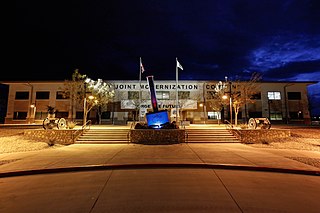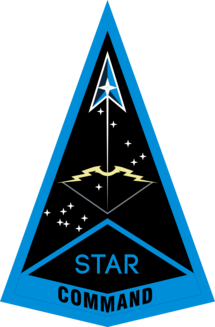Related Research Articles

United States Joint Forces Command (USJFCOM) was a Unified Combatant Command of the United States Department of Defense. USJFCOM was a functional command that provided specific services to the military. The last commander was Army Gen. Ray Odierno. As directed by the President to identify opportunities to cut costs and rebalance priorities, Defense Secretary Robert Gates recommended that USJFCOM be disestablished and its essential functions reassigned to other unified combatant commands. Formal disestablishment occurred on 4 August 2011.
The Combat Capabilities Development Command (CCDC) C5ISR Center, formerly the Communications-Electronics RD&E Center (CERDEC), is the United States Army information technologies and integrated systems center. CCDC C5ISR Center is headquartered at Aberdeen Proving Ground in Maryland, with activities at Fort Belvoir in Virginia and Joint Base McGuire-Dix-Lakehurst in New Jersey.

The Department of Defense Architecture Framework (DoDAF) is an architecture framework for the United States Department of Defense (DoD) that provides visualization infrastructure for specific stakeholders concerns through viewpoints organized by various views. These views are artifacts for visualizing, understanding, and assimilating the broad scope and complexities of an architecture description through tabular, structural, behavioral, ontological, pictorial, temporal, graphical, probabilistic, or alternative conceptual means. The current release is DoDAF 2.02.

Allied Command Transformation (ACT) is a military command of the North Atlantic Treaty Organization (NATO), formed in 2003 after restructuring.
Concept development and experimentation (CD&E) is the application of the structure and methods of experimental science to the challenge of developing future military capability.
The UAV Battlelab is a U.S. Air Force flight test and development facility specifically dedicated to developing unmanned aerial vehicles. One of six original Air Force battlelabs established in 1997, this battlelab falls directly under the Air Warfare Center and recently moved to Creech Air Force Base, located near Indian Springs, Nevada from Eglin Air Force Base, Florida.
The Command and Control Research Program (CCRP) was an active DoD Research Program from 1994 to 2015. It was housed within the Office of the Assistant Secretary of Defense (NII) and it focused upon (1) improving both the state of the art and the state of the practice of command and control (C2) and (2) enhancing DoD's understanding of the national security implications of the Information Age. It provides "Out of the Box" thinking and explores ways to help DoD take full advantage of Information Age opportunities. The CCRP served as a bridge between the operational and technical communities and enhanced the body of knowledge and research infrastructure needed for future progress.
LandWarNet (LWN) is the United States Army’s contribution to the Global Information Grid (GIG) that consists of all globally interconnected, end-to-end set of Army information capabilities, associated processes, and personnel for collecting, processing, storing, disseminating, and managing information on demand supporting warfighters, policy makers, and support personnel. It includes all Army and leveraged Department of Defense (DOD)/Joint communications and computing systems and services, software, data security services, and other associated services. LandWarNet exists to enable the warfighter through Mission Command, previously described as Battle Command. Other U.S. service equivalent efforts to LandWarNet include the Navy's "FORCEnet" and the Air Force's "C2 Constellation."
Purdue University's Synthetic Environment for Analysis and Simulations, or SEAS, is currently being used by Homeland Security and the US Defense Department to simulate crises on the US mainland. SEAS "enables researchers and organizations to try out their models or techniques in a publicly known, realistically detailed environment." It "is now capable of running real-time simulations for up to 62 nations, including Iraq, Afghanistan, and China. The simulations gobble up breaking news, census data, economic indicators, and climactic events in the real world, along with proprietary information such as military intelligence. [...] The Iraq and Afghanistan computer models are the most highly developed and complex of the 62 available to JFCOM-J9. Each has about five million individual nodes representing things such as hospitals, mosques, pipelines, and people."
Capability management is a high-level integrative management function, with particular application in the context of defense.
Live, Virtual, & Constructive (LVC) Simulation is a broadly used taxonomy for classifying Models and Simulation (M&S). However, categorizing a simulation as a live, virtual, or constructive environment is problematic since there is no clear division between these categories. The degree of human participation in a simulation is infinitely variable, as is the degree of equipment realism. The categorization of simulations also lacks a category for simulated people working real equipment.
Mounted Warfare TestBed (MWTB) at Fort Knox, Kentucky, was the premier site for distributed simulation experiments in the US Army for over 20 years. It used simulation systems, including fully manned virtual simulators and computer-generated forces, to perform experiments that examined current and future weapon systems, concepts, and tactics.
The Navy Warfare Development Command (NWDC) is a command of the United States Navy for the generation and development of innovations in concepts and doctrine for enhanced operational level maritime capability and integration in joint and coalition activities. The NWDC is currently located at Naval Station Norfolk, VA.

The U.S. Army Joint Modernization Command, or JMC, based in Fort Bliss, Texas, gains insights from "Fight Tonight" units about future ways of fighting, future technology, and force structure during realistic live, constructive, and/or simulated training exercises. Joint Modernization Command is subordinate to the Army Futures & Concepts Center in Joint Base Langley-Eustis, Virginia; both report to the U.S. Army's newest Four-Star Command, the Army Futures Command (AFC) based in Austin, Texas.
JEFX, or Joint Expeditionary Force Experiment, was the periodic US Air Force-led operational experiment created to evaluate new technologies and war fighting concepts in a simulated wartime battle environment. It was an outgrowth of the C4I Initiative mandated by the Goldwater-Nichols Act of 1986. It was monitored by the Air Force senior leadership and each event culminated with a report for the Chief of Staff of the Air Force.

The Joint Deployable Analysis Team (JDAT) is part of the J6 Directorate of the Joint Chiefs of Staff.

Federated Mission Networking (FMN) is a significant initiative to help ensure interoperability and operational effectiveness of the North Atlantic Treaty Organization, it is a key contribution to the Connected Forces Initiative, helping Allied and Partner forces to better communicate, train and operate together. This includes the NATO Command Structure as well as the NATO Force Structure. The purpose of FMN is ultimately to support Command, Control, Communications, Computers, Intelligence, Surveillance and Reconnaissance (C4ISR) and decision-making in operations by enabling a rapid instantiation of mission networks. Including the NATO Command Structure, 35 nations have joined the FMN initiative as so called "FMN Affiliates" and work together under the FMN Framework Process to coordinate the design, development and delivery of operational and technical capabilities required to conduct net-centric operations. Each development increment is referred to as an "FMN Spiral". The respective requirements, architecture, standards, procedural and technical instructions are documented in so called "FMN Spiral Specifications". FMN Spiral Specifications are based on well known standards and best practices, hence supported by most off-the-shelf products and vendor neutral. TACOMS standards and profiles specify a common, technology and topology independent network interoperability layer for federated mission networks. There is also a rolling 10-year FMN Spiral Specification Roadmap of the envisioned future capabilities. At the same time, the Coalition Interoperability Assurance and Validation (CIAV) process ensures that current interoperability issues are being identified and fed back into FMN capability development.

The United States Army Futures Command (AFC) is a United States Army command, designed as a public-private initiative, that runs modernization projects for the Army. It is headquartered in Austin, Texas, and was first commanded by General John Murray.
Nimble Titan is an Integrated Air and Missile Defense (IAMD) recurring two-year wargame campaign series that provides for national security and military policy experimentation in a notional scenario set 10 years in the future. It is the premier forum of U.S. Strategic Command for developing experimental IAMD national security and military policy among U.S. allies and partners. The experimental nature of the wargame is to stimulate participants to think outside of the constraints of current international and national norms, policies, and procedures.

Space Training and Readiness Command is the United States Space Force's education, training, doctrine, and test field command. It is headquartered at Peterson Space Force Base, Colorado.
References
- ↑ DNBL operating model document Archived February 18, 2013, at the Wayback Machine
- ↑ What are Battle Labs – Do We Still Need Them?
- ↑ GUIDEx Book
- ↑ USAF Battlelabs SAB-TR-00-04 August 2000
- ↑ DoD Command and Control Research Program
- ↑ "List of US battle labs published by the US Air Force Air University". Archived from the original on 2017-07-22. Retrieved 2013-05-12.
- ↑ DNBL overview by the NATO NCIA Archived June 6, 2013, at the Wayback Machine